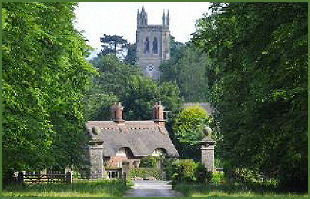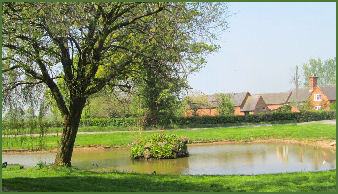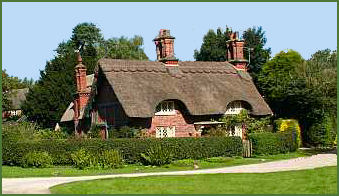Osmaston
OS Grid ref:-
 The picturesque estate village of Osmaston is situated around two and a half miles to the south of the Peak District town of Ashbourne.
The picturesque estate village of Osmaston is situated around two and a half miles to the south of the Peak District town of Ashbourne.
The village is mentioned in the Domesday Book of 1086 where it is recorded as 'Osmundestone'. The original name of the parish was White Stone, which name derives from the limestone of the White Peak area.
A picture postcard village in the truest sense of the word, with half timbered, thatched cottages and a village pond, thatched cottages are rare in the Peak District, but in Osmaston, even the village hall has a thatched roof. The pond is situated at the bottom of the village by the two oldest cottages in Osmaston, an unusual seat, made of discarded horseshoes, overlooks the pond. The four thatched cottages which face the car park, known as 'the Coronation cottages' were constructed to mark the coronation of King George VI. The village war memorial is situated near the church. The only pub in the village is 'The Shoulder of Mutton', which provides quality, home prepared food.
 Most of the buildings which the visitor to Osmaston sees today date to around 1850 when the village was redeveloped by Francis Wright to serve Osmaston Manor. Osmaston Manor was the home of the wealthy industrialist and influential Francis Wright, whose family were Nottingham bankers and had made a considerable fortune from iron and coal production during the Industrial Revolution. Francis Wright died in 1873, there is a memorial to him in nearby Ashbourne Market Place.
Most of the buildings which the visitor to Osmaston sees today date to around 1850 when the village was redeveloped by Francis Wright to serve Osmaston Manor. Osmaston Manor was the home of the wealthy industrialist and influential Francis Wright, whose family were Nottingham bankers and had made a considerable fortune from iron and coal production during the Industrial Revolution. Francis Wright died in 1873, there is a memorial to him in nearby Ashbourne Market Place.
Osmaston Hall, once a superb mock tudor manor house which echoed Tissington Hall in style, was designed by Henry Isaac Stevens. Sadly, the hall was demolished in 1964. The estate was puechased by Sir Ian Walker's family in 1988. All that remains today is the tower, garden terraces and a saw mill which still has its original water wheel. The surrounding park, which is still owned by the Walker-Okeover family, is however, open to the public.
 The village church of St. Martin's dates back to 1606, although the present building was constructed in 1843 and was designed by H.I.Stevens. It has been claimed that a stone in the previous church here was engraved with the date AD cccccc - revealing that the church was founded in the seventh century. It isd thought that the previous church was made of wickerwork. The present church contains a number of tributes to its benefactors, the Wright family.
The village church of St. Martin's dates back to 1606, although the present building was constructed in 1843 and was designed by H.I.Stevens. It has been claimed that a stone in the previous church here was engraved with the date AD cccccc - revealing that the church was founded in the seventh century. It isd thought that the previous church was made of wickerwork. The present church contains a number of tributes to its benefactors, the Wright family.
The Ashbourne Agricultural Show, organised by the Ashbourne Shire Horse Society, is held in the village annually on the third Saturday of August every year.
Directions
From Ashbourne take the A52 heading for Derby, turn right at the signpost. Car parking is provided at the village hall.
Nearby places of interest
The Burrows Garden is situated 5 miles to the south east of Ashbourne. Set in beautiful countryside, the superb gardens cover 5 acres.
Dovedale, a dramatic limestone ravine, with its mpressive rock outcrops and tranquil woodlands is arguably the prettiest of the dales in the Peak District National Park and is owned by the National Trust.
The Manifold Valley, which runs almost parallel with Dovedale, has been described as the 'Switzerland of Staffordshire' and offers some of the most spectacular scenery in the Peak District National Park.
Biddulph Grange, one of Britain's most exciting and unusual gardens, was created by the horticulturalist James Bateman (1811–1897), for his large collection of plants from around the world.
Haddon Hall near Bakewell, is an architectural gem. Dating back to the eleventh century, the hall has been described as "the most complete and most interesting house of [its] period", it is the finest example of a medieval manor house currently in existence in England.
